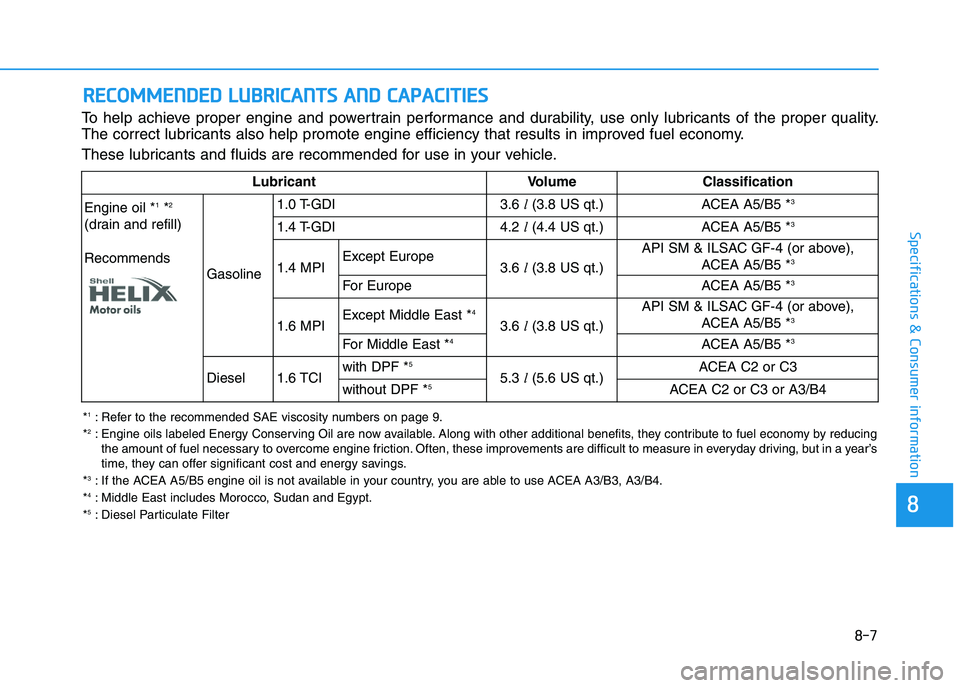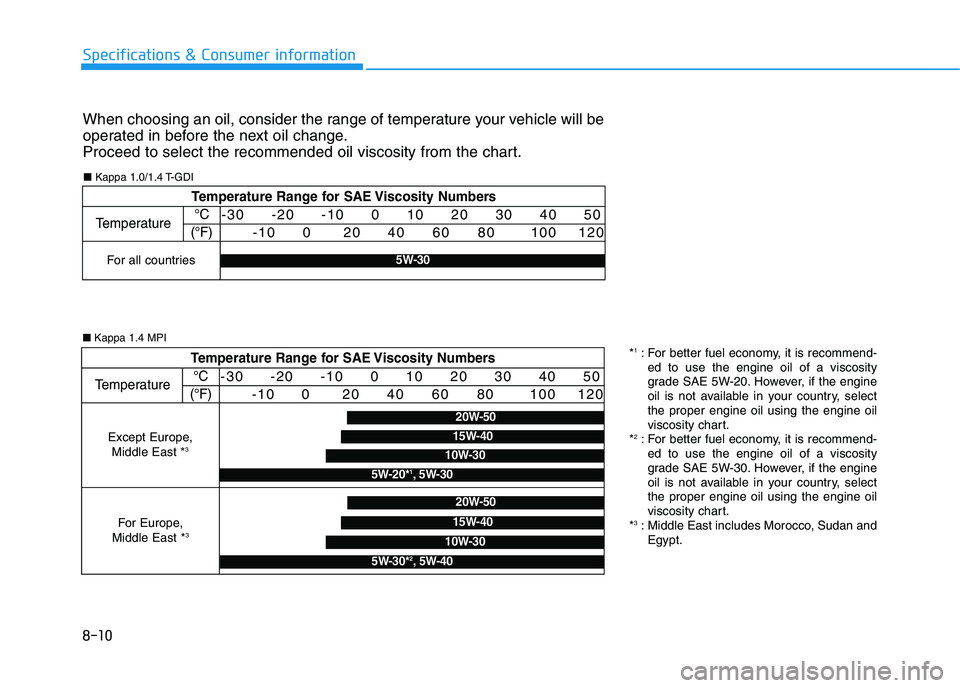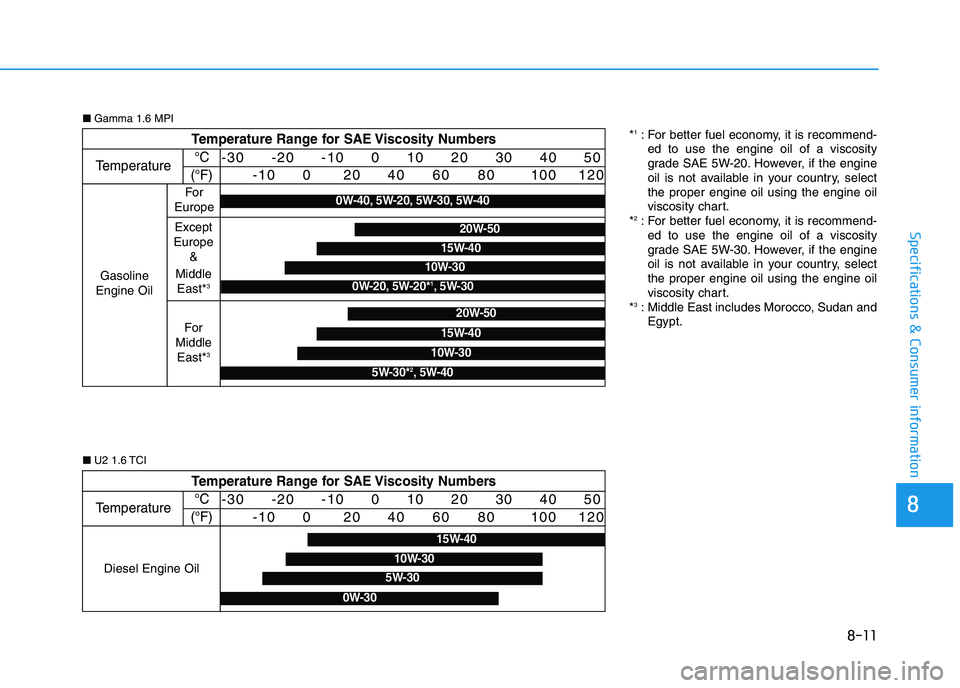Page 458 of 659

5-154
Driving your vehicle
Check battery and cables
The winter temperature increases
the battery consumption. Inspect
the battery and cables, as speci-
fied in the chapter 7. The battery
charging level can be checked by an
authorized HYUNDAI dealer or in a
service station.
Change to "winter weight" oil if
necessary
In some regions during winter, it is
recommended to use the "winter
weight" oil with lower viscosity. For
further information, refer to the chap-
ter 8. When you are not sure about a
type of winter weight oil, consult an
authorized HYUNDAI dealer. Check spark plugs and ignition
system
Inspect the spark plugs, as speci-
fied in the chapter 7.
If necessary,
replace them. Also check all ignition
wirings and components for any
cracks, wear-out, and damage.
To prevent locks from freezing
To prevent the locks from being
frozen, spray approved de-icing fluid
or glycerin into key holes. When a
lock opening is already covered with
ice, spray approved de-icing fluid
over the ice to remove it. When an
internal part of a lock freezes, try to
thaw it with a heated key. Carefully
use the heated key to avoid an injury. Use approved window washer
anti-freeze solution in system
To prevent the window washer from
being frozen, add authorized window
washer anti-freeze solution, as spec-
ified on the window washer contain-
er. Window washer anti-freeze solu-
tion is available from an authorized
HYUNDAI dealer, and so are the
most vehicle accessory outlets. Do
not use engine coolant or other types
of anti-freeze solution to prevent any
damage to the vehicle paint.
Page 629 of 659

8
Specifications & Consumer information
8
Specifications & Consumer information
8
Dimensions ..............................................................8-2
Engine ......................................................................8-2
Bulb wattage ...........................................................8-3
Tires and wheels ....................................................8-4
Load and speed capacity tires (for europe)......8-5
Air conditioning system ........................................8-6
Vehicle weight and luggage volume ....................8-6
Recommended lubricants and capacities ...........8-7
Recommended engine oil (For Europe) .......................8-9
Recommended SAE viscosity number ..........................8-9
Vehicle identification number (VIN) ..................8-12
Vehicle certification label ...................................8-12
Tire specification and pressure label ...............8-13
Engine number .....................................................8-13
Air conditioner compressor label ......................8-14
Refrigerant label ..................................................8-14
Declaration of conformity ..................................8-14
Page 635 of 659

8-7
Specifications & Consumer information
R
R E
E C
C O
O M
M M
M E
E N
N D
D E
E D
D
L
L U
U B
B R
R I
I C
C A
A N
N T
T S
S
A
A N
N D
D
C
C A
A P
P A
A C
C I
I T
T I
I E
E S
S
To help achieve proper engine and powertrain performance and durability, use only lubricants of the proper quality.
The correct lubricants also help promote engine efficiency that results in improved fuel economy.
These lubricants and fluids are recommended for use in your vehicle.
Lubricant Volume Classification
Engine oil *
1*2
(drain and refill)
Recommends Gasoline1.0 T-GDI
3.6
l(3.8 US qt.)
ACEA A5/B5 *
3
1.4 T-GDI 4.2
l(4.4 US qt.)
ACEA A5/B5 *3
1.4 MPIExcept Europe
3.6 l(3.8 US qt.) API SM & ILSAC GF-4 (or above),
ACEA A5/B5 *3
For Europe ACEA A5/B5 *3
1.6 MPI Except Middle East *
4
3.6
l(3.8 US qt.) API SM & ILSAC GF-4 (or above),
ACEA A5/B5 *3
For Middle East *4ACEA A5/B5 *3
Diesel 1.6 TCI with DPF *
5
5.3
l(5.6 US qt.) ACEA C2 or C3
without DPF *5ACEA C2 or C3 or A3/B4
8
*1: Refer to the recommended SAE viscosity numbers on page 9.
*2: Engine oils labeled Energy Conserving Oil are now available. Along with other additional benefits, they contribute to fuel econ omy by reducing
the amount of fuel necessary to overcome engine friction. Often, these improvements are difficult to measure in everyday driving , but in a year’s
time, they can offer significant cost and energy savings.
*
3: If the ACEA A5/B5 engine oil is not available in your country, you are able to use ACEA A3/B3, A3/B4.
*4: Middle East includes Morocco, Sudan and Egypt.
*5: Diesel Particulate Filter
Page 637 of 659

8-9
8
Specifications & Consumer information
Recommended engine oil (For Europe)
Supplier ProductShell Gasoline Engine
HELIX ULTRA AH-E 5W-30
HELIX ULTRA 5W-40
Diesel Engine HELIX ULTRA AP 5W-30
HELIX ULTRA AP-L 5W-30
Always be sure to clean the area around any filler plug, drain plug, or dipstick before checking or draining
any lubricant. This is especially important in dusty or sandy areas and when the vehicle is used on unpaved
roads. Cleaning the plug and dipstick areas will prevent dirt and grit from entering the engine and other
mechanisms that could be damaged.
CAUTION
Recommended SAE viscosity number
Engine oil viscosity (thickness) has an effect on fuel economy and cold weather operating (engine start and engine oil
flowability). Lower viscosity engine oils can provide better fuel economy and cold weather performance, however, high-
er viscosity engine oils are required for satisfactory lubrication in hot weather. Using oils of any viscosity other than
those recommended could result in engine damage.
Page 638 of 659

8-10
Specifications & Consumer information
When choosing an oil, consider the range of temperature your vehicle will be
operated in before the next oil change.
Proceed to select the recommended oil viscosity from the chart.
Temperature Range for SAE Viscosity Numbers
Temperature°C
(°F)-30 -20 -10 0 10 20 30 40 50 -10 0 20 40 60 80 100 120
For all countries5W-30
■Kappa 1.0/1.4 T-GDI
■ Kappa 1.4 MPI
Temperature Range for SAE Viscosity Numbers
Temperature °C
(°F)-30 -20 -10 0 10 20 30 40 50 -10 0 20 40 60 80 100 120
20W-50
10W-30
15W-40
5W-30*2, 5W-40
20W-50
15W-40
10W-30
5W-20*1, 5W-30
Except Europe, Middle East *3
For Europe,
Middle East *3
*1: For better fuel economy, it is recommend- ed to use the engine oil of a viscosity
grade SAE 5W-20. However, if the engine
oil is not available in your country, select
the proper engine oil using the engine oil
viscosity chart.
*
2: For better fuel economy, it is recommend- ed to use the engine oil of a viscosity
grade SAE 5W-30. However, if the engine
oil is not available in your country, select
the proper engine oil using the engine oil
viscosity chart.
*
3: Middle East includes Morocco, Sudan and Egypt.
Page 639 of 659

8-11
8
Specifications & Consumer information
Temperature Range for SAE Viscosity Numbers
Temperature°C
(°F)-30 -20 -10 0 10 20 30 40 50 -10 0 20 40 60 80 100 120
5W-30
15W-40
10W-30
0W-30
Diesel Engine Oil
■U2 1.6 TCI
Temperature Range for SAE Viscosity Numbers
Temperature
Gasoline
Engine Oil
°C
(°F)-30 -20 -10 0 10 20 30 40 50 -10 0 20 40 60 80 100 120
For
Europe
20W-50
10W-30
15W-40
5W-30*2, 5W-40
0W-40, 5W-20, 5W-30, 5W-40
20W-50
15W-40
10W-30
0W-20, 5W-20*1, 5W-30
Except
Europe &
Middle East*
3
For
Middle East*
3
■ Gamma 1.6 MPI
*1: For better fuel economy, it is recommend-
ed to use the engine oil of a viscosity
grade SAE 5W-20. However, if the engine
oil is not available in your country, select
the proper engine oil using the engine oil
viscosity chart.
*
2: For better fuel economy, it is recommend- ed to use the engine oil of a viscosity
grade SAE 5W-30. However, if the engine
oil is not available in your country, select
the proper engine oil using the engine oil
viscosity chart.
*
3: Middle East includes Morocco, Sudan and Egypt.